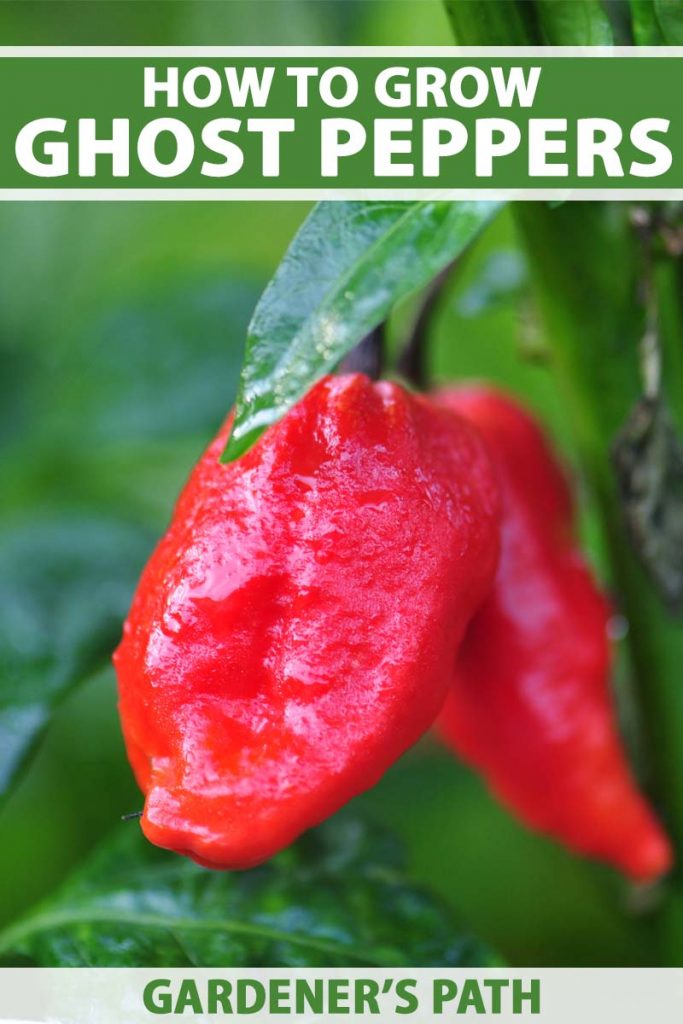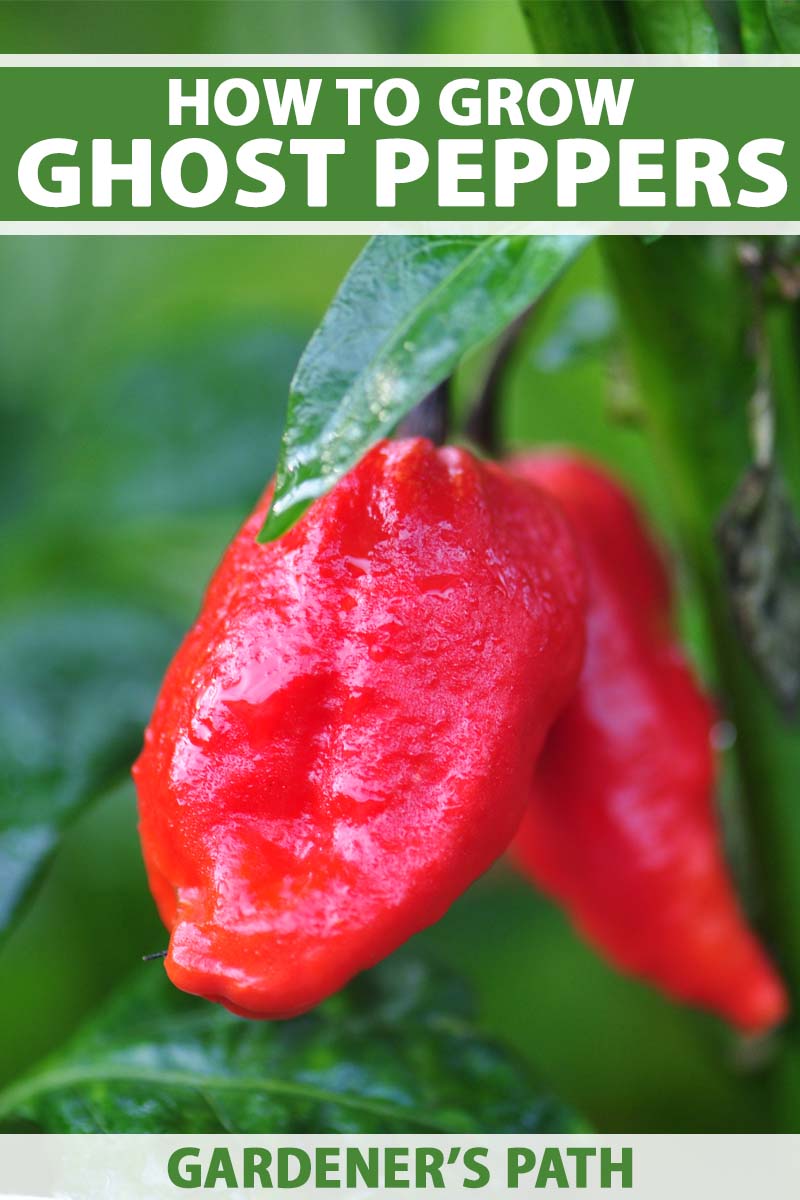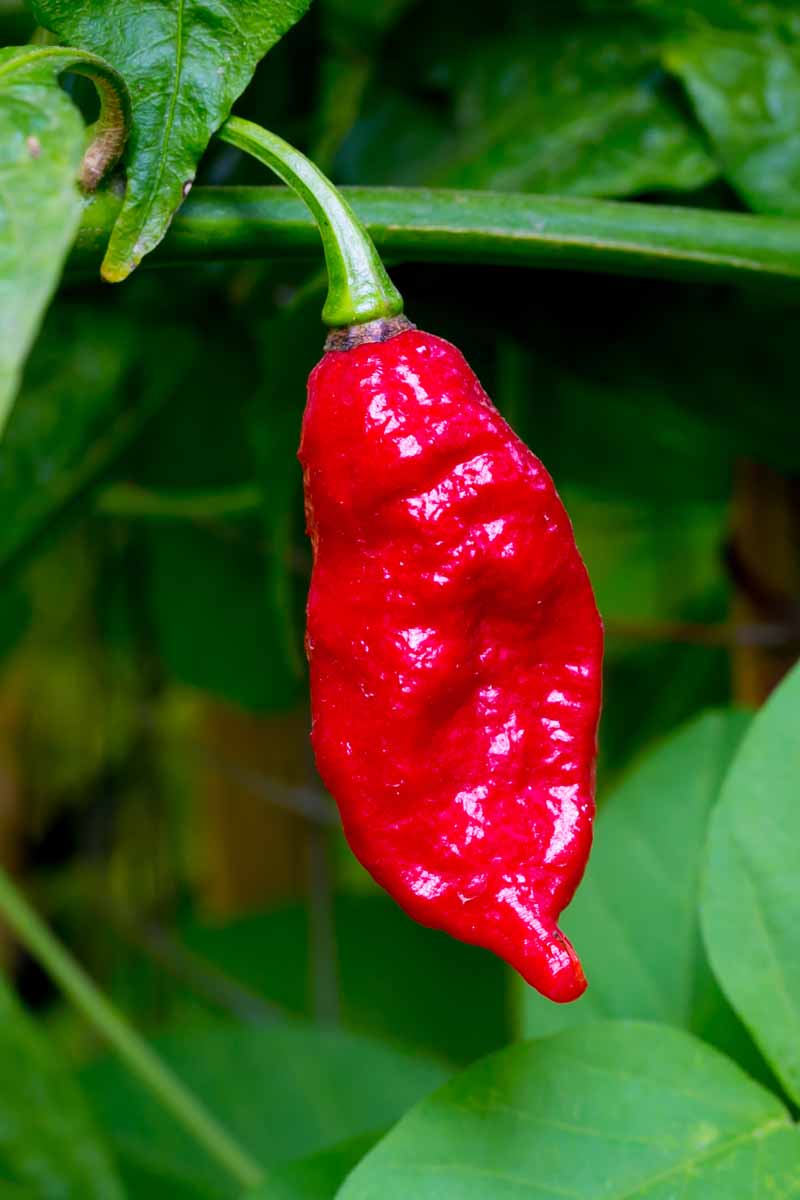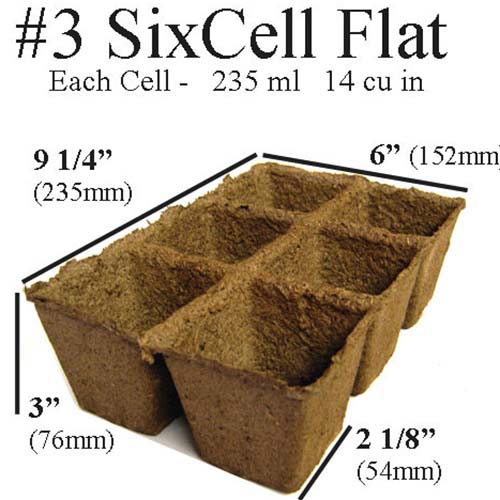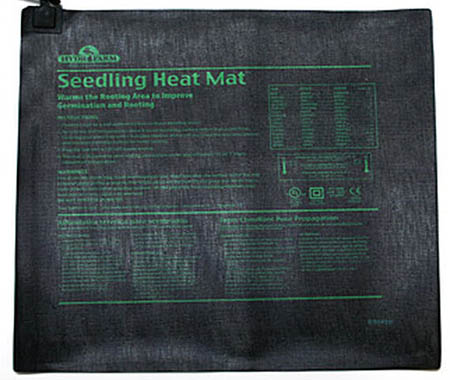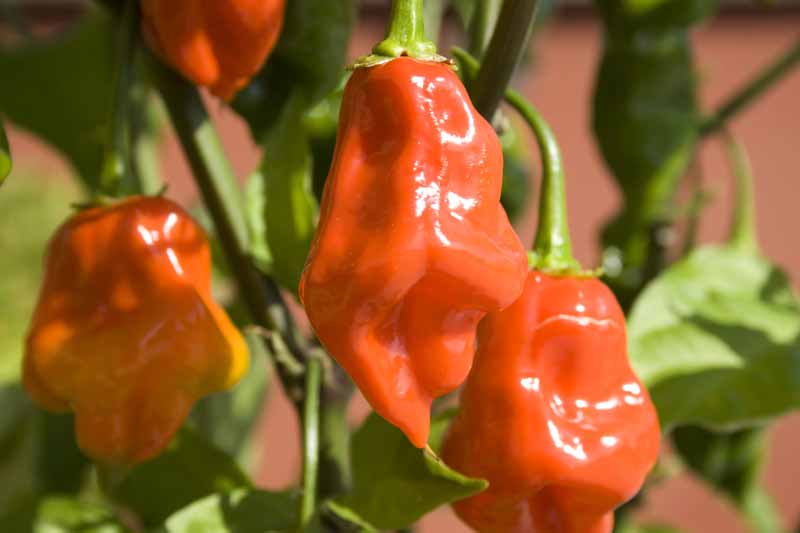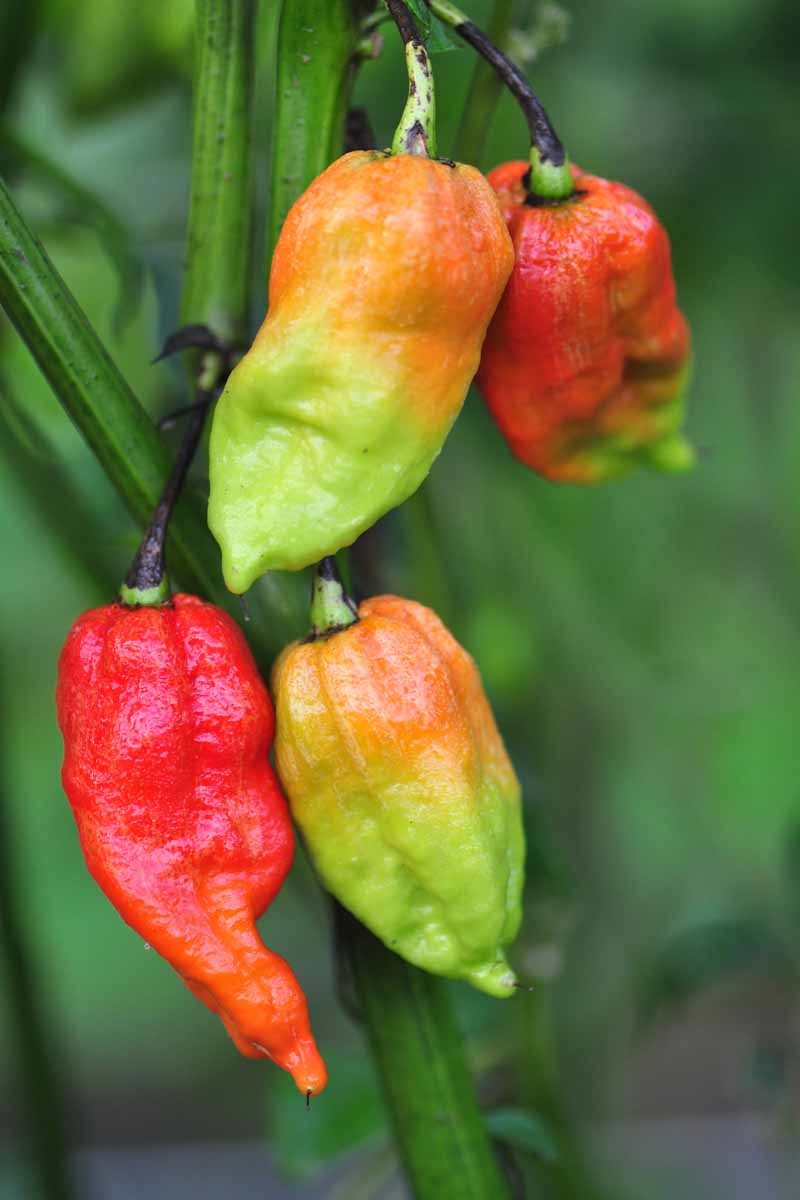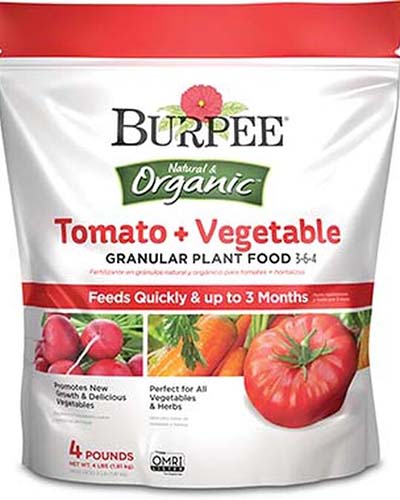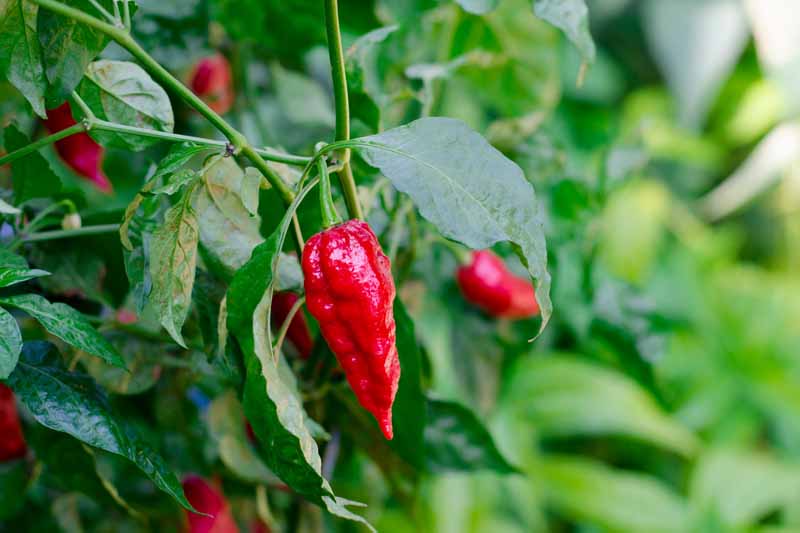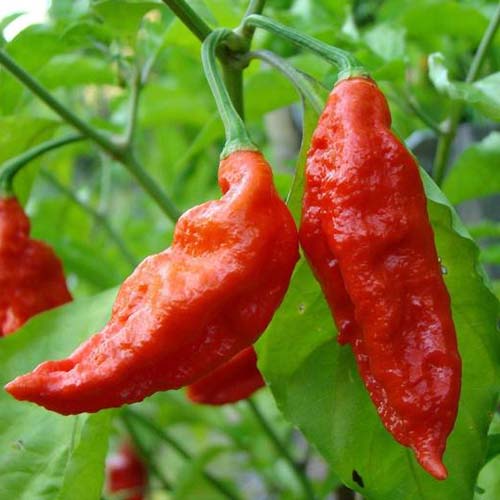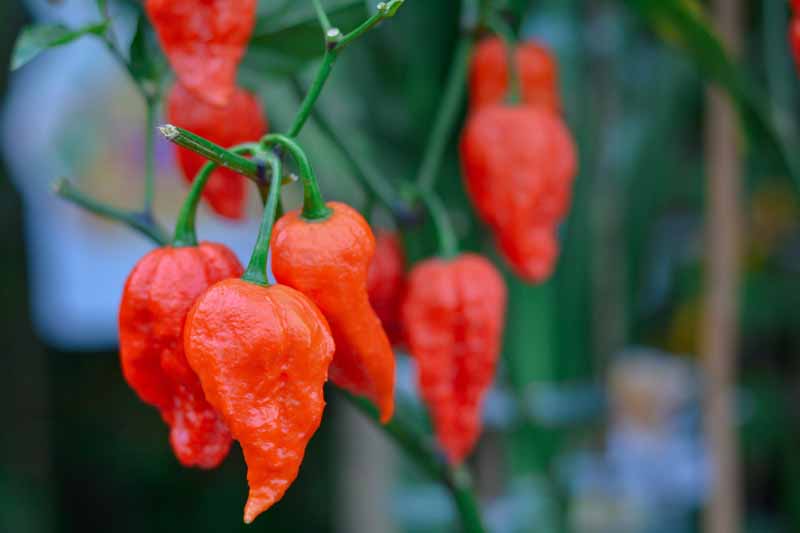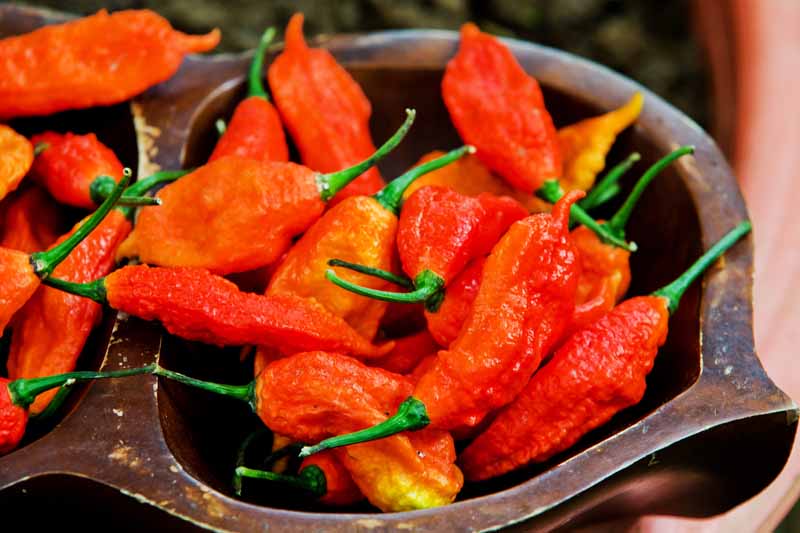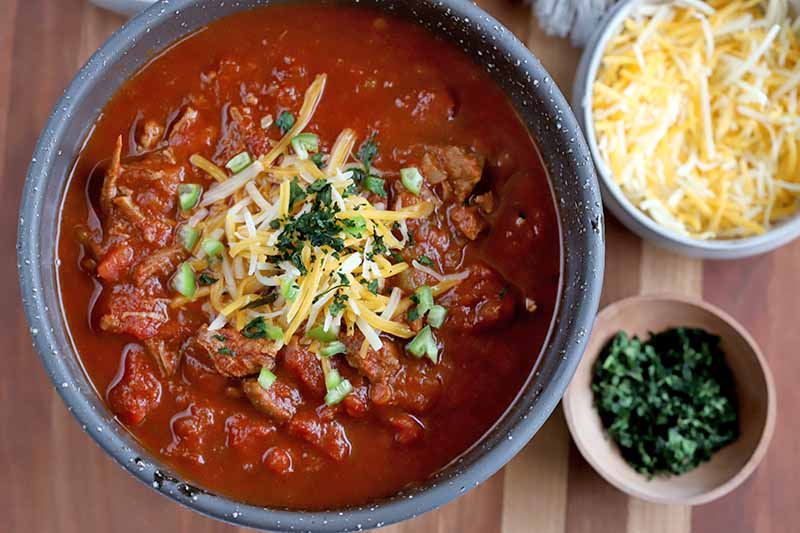In 2007 it was listed in the Guinness Book of World Records as the “hottest pepper in the world” – but it has since been knocked off its podium by the sinister-sounding ‘Carolina Reaper.’ The “heat” of a pepper is measured in Scoville heat units (SHU), which measures the concentration of capsaicin. We link to vendors to help you find relevant products. If you buy from one of our links, we may earn a commission. So at over a million SHU, what can we possibly do with ghost peppers, and why would anyone want to grow them? Because they are delicious. In very small quantities.
What Is a Ghost Pepper?
The ghost pepper, bhut jolokia, also known as naga jolokia or ghost chili, is a member of the nightshade family, Solanaceae, which includes eggplant, tomatoes, and of course, the bell pepper, Capsicum annuum – which has a Scoville rating of 0.
The Capsicum genus comprises over 200 species, and the ghost was thought to be an interspecific hybrid of C. chinense, a habanero type pepper, and C. frutescens. Cultivated in northeast India, primarily in the Assam region, as of 2018, it has been reclassified as its own species, C. assamicum, on the basis of morphological studies. Bhut jolokia is a tender perennial, often grown as an annual, suitable for gardeners in USDA Hardiness Zones 8-11. Ripe peppers are usually red, two to three inches long and about an inch wide, with slightly wrinkled skin. They taper to a small point at the bottom of the pod.
In the right conditions, plants can reach a mature height of four feet, though mine have never managed more than two feet, but have never failed to provide me with an abundant harvest. Apart from the mind-blowing heat, bhut jolokia has an almost sweet, smoky aftertaste. It’s not advisable to eat it raw. It’s a good elephant deterrent. In parts of India, ground-up ghost peppers are smeared on fencing to keep crops safe from wild elephants. This is a tactic used in parts of Africa as well, to good effect. On that basis, it’s unlikely you’ll have a problem with deer! You can refer to our hot pepper growing guide to learn more. Here I’m going to cover specific tips for cultivating ghost peppers in your garden.
When and How to Plant
Ghost peppers require a long growing season – up to 150 days from planting to harvest – so it’s best to start seeds indoors at least eight to 10 weeks before the average last frost date in your area. Soak seeds in a little water overnight before sowing. Be patient, as it can sometimes take up to 35 days for sprouts to appear. If you are using a heat mat, you’ll need to be vigilant with your watering as the soil can dry out quickly.
Cow Pots™ Biodegradable Seed Trays You can use peat pots, but I really like Cow Pots™, as they are made from composted cow manure from a dairy farm in Vermont and will nourish your plants as they break down. Find Cow Pots™ in a variety of sizes from Arbico Organics. Seeds need an even soil temperature of 80-90°F in order to germinate.
Heat Mat for Seedlings Keep the soil evenly moist, but not waterlogged, and in 14-21 days your seeds should germinate. After germination, move them to a sunny windowsill or place seedlings under grow lights. Keep the grow lights two to three inches above the top of the sprouts. Continue to water regularly, keeping the soil moist – but be careful not to overwater. Seedlings thrive in daytime temperatures above 70°F, and no less than 60°F at night. Once your seedlings are four to six inches tall – about six to eight weeks after germination – it’s time to transplant them out into the garden, or into a container.
If you intend to grow them in containers, make sure your pot is at least eight inches deep and 11-12 inches wide. Before planting out, you’ll need to harden off your seedlings. To do this, decrease the daytime temperature to 60-65°F for one week before planting out. Alternatively, place the plants in a sunny but sheltered area outdoors for a few hours each day, gradually increasing the amount of time they spend outside. To get a jump on the growing season, you can purchase transplants from your local nursery and harden them off prior to planting out.
How to Grow
In their native environment, these peppers grow in hot, humid conditions.
Ghost peppers require a full sun location, and well-drained, organically rich, fertile soil, with a pH of 6.0-6.8. You may wish to conduct a soil test to determine the pH and nutrient level of your soil and amend accordingly. After all risk of frost has passed, and nighttime temperatures are above 60°F, you can plant your baby peppers. Space plants 24-36 inches apart. Dig a hole the size of the root ball – or biodegradable pot, if using – and place the transplant into the hole, tamp down the soil, and water in well. Unlike tomatoes, peppers do not need their stems to be buried. You can mulch with compost or straw to help prevent weeds and retain moisture, just make sure to keep the mulch at least an inch away from the stem to prevent rot. You can use floating row covers to maintain an even temperature and protect young plants from wind and driving rain. Ghost peppers require regular watering, about 1 inch per week, but they do not like wet feet. Check your soil, and if it’s dry to an inch deep, the plants need water. Be extra vigilant when flower buds form, and maintain even moisture. As they grow, you may need to stake your plants or use a tomato cage to prevent the stem from breaking in high winds, particularly when fruiting.
Tomato + Vegetable Granular Plant Food You can find tomato food at your local garden center or from Burpee. Bhut jolokia plants are very sensitive to temperature changes. The ideal temperature is between 70 and 90°F, and rapid changes can cause the plant to drop its flowers, or fail to thrive. I like to pinch the growing tips to encourage a bushier plant, though this is not absolutely necessary.
Here in Zone 9b I grow my bhuts in containers on my deck. This way, I can ensure they get enough sunlight (six to eight hours per day) and they are protected from heavy rain and excessive wind. Over the winter months, I prune them hard, and then they overwinter in my garage. I’ve had some success with a good crop from my second-year plants, but my third-year plants have not been very abundant this season. Fruit will start out green and gradually turn red – or yellow, depending on the cultivar you are growing. They are ready to harvest when they have turned fully red, and the skin is slightly wrinkled.
From the time I see the flowers start to appear, I feed my container plants every two weeks with tomato food and spray with an Epsom salt mixture on the alternate weeks. The Epsom salt provides a source of magnesium to the plant, which helps to increase fruit yield. To do this, I dissolve 2 tablespoons of Epsom salt into a spray bottle filled with warm water and use it as a foliar spray. Plants that are deficient in magnesium will produce lots of flowers but fail to set fruit.
Growing Tips
Plant in a full sun location, with organically rich soil. Fertilize regularly with 5-10-10 (NPK) or tomato food. Keep soil moist but avoid overwatering.
Where to Buy
You can often find transplants available at your local garden center to get you started.
4” Ghost Pepper Plants via Bonnie Plants Bonnie Plants offers 4-inch plants in 19-ounce pots, available at Home Depot.
Ghost Pepper Seeds via Eden Brothers Or, if you want to try your luck with starting seeds, you can find packets in a variety of sizes available at Eden Brothers.
Managing Pests and Disease
Given that ghost peppers can be used to deter elephants, you’d be forgiven for thinking that they are untroubled by pests and disease. Unfortunately, that’s not always the case. Aphids can enjoy feeding on your plants, but a strong blast from the hose can be enough to get rid of them. If they persist, then I recommend spraying with neem oil. I do this once a week, making sure to target both the top and bottom of the foliage. Check out this guide to learn more about managing aphids in your garden. Spider mites, thrips, and flea beetles can also cause damage. Keep an eye out for these, and spray with neem oil, or apply diatomaceous earth. To deter slugs and snails, I use beer traps. Diseases that you might encounter include fungal leaf spot and powdery mildew, which can also be treated with neem oil or a targeted fungicide. Bacterial leaf spot, caused by Xanthomonas campestris, is a serious disease that’s usually a result of planting infected transplants or seeds. Plants will need to be removed and destroyed.
Harvesting and Preserving
It’s been a long wait! About 120-150 days after starting your tiny plants, you will be rewarded with bright red peppers to liven up your garden and blow your head off.
Harvesting is easy, just cut off the peppers as they ripen. It’s recommended to wear gloves when you handle ghost peppers, and avoid contact with your skin – and definitely avoid touching your eyes or any other sensitive regions after handling. Like other hot varieties, ghosts will last five to seven days in the refrigerator, after which time they can start to get mushy and possibly discolored. I like to freeze my peppers. To do this, I simply place them in a plastic container or baggie and store them in the freezer – they’ll last for six months to a year. You can also dry them. Using a dehydrator or a very low oven, spread them out whole, and keep an eye out for when they shrivel up. Store in a cool, dark, dry spot in an airtight container.
Recipes and Cooking Ideas
A little goes a very long way. Ghosts can be added to all your favorite recipes that call for hot peppers. But be careful – even if you are used to throwing in habaneros by the handful, the ghost is up to 11 times hotter!
To prepare your ghost pepper, you’ll need to remember that the capsaicin will not just infuse your food with mind-blowing heat, but also your chopping board, and skin that comes into contact with it. Wear gloves and eye protection when handling it – and wash your hands thoroughly before touching your eyes, mouth, or other sensitive areas. Remove and discard the seeds and inner membrane, and slice thinly. My recommendation is to start slowly, adding a very small amount at a time to your favorite chili or salsa recipes. I love this recipe for slow cooker game day chili, from our sister site, Foodal. You can also make hot sauce, infused oil, or add it to your favorite salsa recipes – you can find some good ideas over at Foodal. Remember that the flavor will develop over time. Your hot sauce will get spicier the longer you store it.
Quick Reference Growing Guide
Respect the Ghost
I once added an entire ghost pepper to my beef chili. I mistook it for a habanero. That was a mistake I won’t be making again. One bite and the heat was overwhelming. I ended up making a fresh batch of chili and mixing the two together. It was still one of the hottest dishes I’ve ever eaten.
In small quantities, the ghost gives a delicious depth of spiciness, but it needs respect. Have you grown ghost peppers? Are you tempted to try? Let us know in the comments and share your favorite recipes! If you want to learn more about growing peppers, you’ll need the following guides next:
How to Grow Ornamental Peppers How to Plant and Grow Serrano Peppers How to Plant and Grow Poblano Peppers
Photos by Clare Groom and Meghan Yager © Ask the Experts, LLC. ALL RIGHTS RESERVED. See our TOS for more details. Product photos via Arbico Organics, Bonnie Plants, Burpee, and Eden Brothers. Uncredited photos: Shutterstock.
